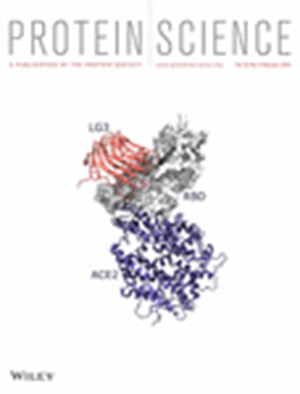HER4 is a high‐affinity dimerization partner for all EGFR/HER/ErbB family proteins
IF 4.5
3区 生物学
Q1 BIOCHEMISTRY & MOLECULAR BIOLOGY
引用次数: 0
Abstract
Human epidermal growth factor receptors (HER)—also known as EGFR or ErbB receptors—are a subfamily of receptor tyrosine kinases (RTKs) that play crucial roles in cell growth, division, and differentiation. HER4 (ErbB4) is the least studied member of this family, partly because its expression is lower in later stages of development. Recent work has suggested that HER4 can play a role in metastasis by regulating cell migration and invasiveness; however, unlike EGFR and HER2, the precise role that HER4 plays in tumorigenesis is still unresolved. Early work on HER family proteins suggested that there are direct interactions between the four members, but to date, there has been no single study of all four receptors in the same cell line with the same biophysical method. Here, we quantitatively measure the degree of association between HER4 and the other HER family proteins in live cells with a time‐resolved fluorescence technique called pulsed interleaved excitation fluorescence cross‐correlation spectroscopy (PIE‐FCCS). PIE‐FCCS is sensitive to the oligomerization state of membrane proteins in live cells, while simultaneously measuring single‐cell protein expression levels and diffusion coefficients. Our PIE‐FCCS results demonstrate that HER4 interacts directly with all HER family members in the cell plasma membrane. The interaction between HER4 and other HER family members intensified in the presence of a HER4‐specific ligand. Our work suggests that HER4 is a preferred dimerization partner for all HER family proteins, even in the absence of ligands.HER4 是所有表皮生长因子受体/HER/ErbB 家族蛋白的高亲和性二聚化伙伴
人类表皮生长因子受体(HER)--又称表皮生长因子受体或 ErbB 受体--是受体酪氨酸激酶(RTKs)的一个亚家族,在细胞生长、分裂和分化过程中起着至关重要的作用。HER4(ErbB4)是这个家族中研究最少的成员,部分原因是它在发育后期的表达较低。最近的研究表明,HER4 可通过调节细胞迁移和侵袭性而在转移中发挥作用;然而,与表皮生长因子受体和 HER2 不同,HER4 在肿瘤发生中的确切作用仍未得到解决。关于 HER 家族蛋白的早期研究表明,这四种成员之间存在直接的相互作用,但迄今为止,还没有用同一种生物物理方法对同一细胞系中的所有四种受体进行过研究。在这里,我们利用一种名为脉冲交错激发荧光交叉相关光谱(PIE-FCCS)的时间分辨荧光技术,定量测量了活细胞中 HER4 与其他 HER 家族蛋白之间的关联程度。PIE-FCCS 对活细胞中膜蛋白的寡聚状态非常敏感,同时还能测量单细胞蛋白质的表达水平和扩散系数。我们的 PIE-FCCS 结果表明,HER4 直接与细胞质膜中的所有 HER 家族成员相互作用。在 HER4 特异性配体存在的情况下,HER4 与其他 HER 家族成员之间的相互作用会加强。我们的研究表明,即使在没有配体的情况下,HER4 也是所有 HER 家族蛋白的首选二聚化伙伴。
本文章由计算机程序翻译,如有差异,请以英文原文为准。
求助全文
约1分钟内获得全文
求助全文
来源期刊

Protein Science
生物-生化与分子生物学
CiteScore
12.40
自引率
1.20%
发文量
246
审稿时长
1 months
期刊介绍:
Protein Science, the flagship journal of The Protein Society, is a publication that focuses on advancing fundamental knowledge in the field of protein molecules. The journal welcomes original reports and review articles that contribute to our understanding of protein function, structure, folding, design, and evolution.
Additionally, Protein Science encourages papers that explore the applications of protein science in various areas such as therapeutics, protein-based biomaterials, bionanotechnology, synthetic biology, and bioelectronics.
The journal accepts manuscript submissions in any suitable format for review, with the requirement of converting the manuscript to journal-style format only upon acceptance for publication.
Protein Science is indexed and abstracted in numerous databases, including the Agricultural & Environmental Science Database (ProQuest), Biological Science Database (ProQuest), CAS: Chemical Abstracts Service (ACS), Embase (Elsevier), Health & Medical Collection (ProQuest), Health Research Premium Collection (ProQuest), Materials Science & Engineering Database (ProQuest), MEDLINE/PubMed (NLM), Natural Science Collection (ProQuest), and SciTech Premium Collection (ProQuest).
 求助内容:
求助内容: 应助结果提醒方式:
应助结果提醒方式:


